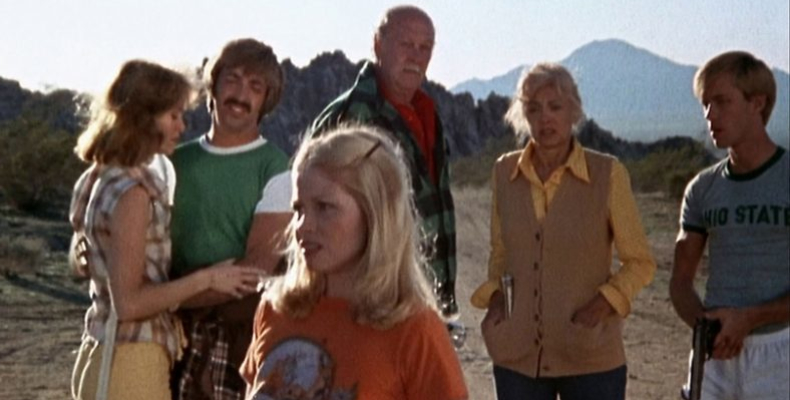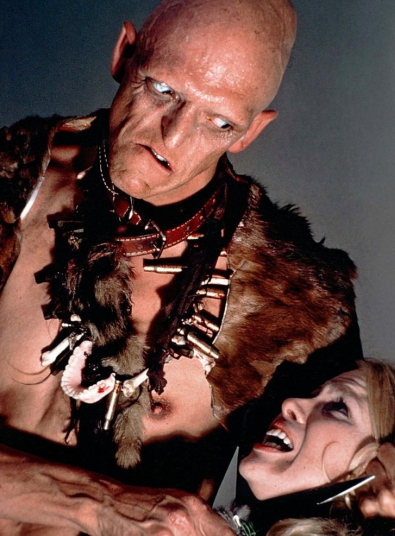The Brady Bunch Go Savage | The Hills Have Eyes at 40.
In sixteenth Century Scotland, Sawney Bean and his inbred family of cave-dwelling cannibals were captured and executed for over a thousand murders. King James had them rounded up and executed by hanging, burning and disembowelment. That’s how the folk tale goes anyway. Four hundred years later fledgling horror film director Wes Craven read the rural folk tale and wrote the script for The Hills Have Eyes. What followed set the tone for desert horror for the next four decades.
While travelling through the Nevada desert towards California, the Carters, a clean cut and all-American family stop at a gas station run by Fred (John Steadman). He warns them to stay on the main road and to avoid the hills. Heedless of his advice the family stray off the beaten track and are ambushed and slowly picked off by a family of depraved, murderous hill folk. It’s a story we’ve all heard before, even if you haven’t see the movie The Hills Have Eyes is so ingrained in the horror zeitgeist that it’s a hard concept to claim ignorance of.
Wes Craven is the undisputed master of horror for good or for ill. He has created three of the most iconic horror franchises of the past forty years: Nightmare on Elm Street, Scream and The Hills Have Eyes. He has also written and directed several other paradigmatic horror films such as The Last House on the Left and Wes Craven’s New Nightmare. While most of his films have always tested the limits of taboo it is his early work that remains the most contentious and disturbing.
The Texas Chainsaw Massacre broke the mould for what could be done with the horror genre. Gone were the mutated and supernatural monsters of the 1930s, 1940s and 1950s. Replacing them were humans. Tobe Hooper’s Texas-set nightmare changed the game in 1974 and Wes Craven took the ball and ran with it in 1977. Hooper inverted the American nuclear family by making them a family of chainsaw wielding psychopaths. Craven went a step further and turned the quintessential family into a group of cannibalistic, abusive, and vicious troglodytes capable only of destruction.

The Carters are a wholesome religious family on their way to L.A to take in the sights. That is until Papa Jupiter (James Whitworth) and his ferocious sons Mars (Lance Gordon), Pluto (Michael Berryman) and Mercury (Arthur King) attack. In a matter of hours, they have crucified and immolated patriarch Big Bob Carter (Russ Grieve) and shot mother Ethel (Virginia Vincent) and eldest daughter Lynne (Dee Wallace). As darkness falls it is left to Lynne’s husband Doug (Martin Speer) and teenage children Bobby (Robert Houston) and Brenda (Susan Lanier) to save baby Katie from the cannibal clan’s clutches.
At its heart, The Hills Have Eyes is a B-Movie. A film made on a shoestring budget with an inexperienced cast and crew. Only director of photography Eric Saarinen and the crew he brought with him were experienced. This is why the film has endured over forty years and become a cult classic. The quick, kinetic camerawork, shrieking score and constantly screaming actors are straight out of classic horror. It doesn’t matter if you’re a terrible actor as long as you have a killer set of lungs.

One actor in particular stands out. Michael Berryman, who plays deformed middle son Pluto, is the most recognisable of cast. Born with twenty-six birth defects Berryman decided to turn a curse into a successful and still ongoing career in horror films. Pluto is the quintessential cannibal redneck. He wears fur and bird feathers and carries a large hunting knife. His elongated skull and misaligned eyes make him the perfect human movie monster. Twisted outside and inside. He is the anti-thesis to Bobby Carter. Where Bobby looks like a member of the Brady Bunch that got lost Pluto looks like the evil brother locked in the cellar.
Speaking of evil, The Hills Have Eyes features some things many of today’s viewers may find not just objectionable but downright tasteless as well.
Rape scenes in films are as unnecessary as consensual sex scenes. Consensual sex scenes are uncomfortable viewing, rarely erotic and embarrassing to watch with your parents. Rape scenes meanwhile serve no real purpose other than to disturb the viewer. Some filmmakers have made rape a central plot point of their films like Gaspar Noé’s Irréversible or the infamous rape-revenge thrillers of the exploitation era such as I Spit on Your Grave. The Hills Have Eyes doesn’t really have a rape scene. Pluto and Mars attempt to assault Brenda but are interrupted by Ethel and Dee. Spoilt for choice the savages attack all three women resulting in a great deal of thrashing and clothes tearing but thankfully no sexual assault. It is a testament to how sickening the act is that very few directors use it in their films. With that said this horrible act of transgression serves to get across how truly horrible human nature can be.
Wes Craven’s first film The Last House on the Left, a much-vilified exploitation film, shows how damaging sexual violence can be for a film. Much of the film is lost due to the number of cuts imposed by censors as well as outright bans imposed by various countries. Many of Wes Craven’s films up to and including Scream have been forced to undergo cuts due to violence. Luckily uncut editions have been released allowing horror fans to fill their bloodlust. Of course, due to a prolonged gratuitous and frankly unnecessary rape and murder scene in The Last House on the Left the film remains one of history’s many ‘lost’ films.
The reason I’ve spent a great deal of time talking about Wes Craven’s debut rather than The Hills Have Eyes is because of the lessons learned from it. Gory violence in movies was becoming more commonplace as the 1970s wore on. In 1977 Craven knew what he could get away with and what he couldn’t. By restraining himself Craven made his second feature film much more terrifying.
In the film’s final scene Doug viciously stabs Mercury repeatedly in the chest. The question posed by Craven is a simple one: Are we, the civilised people, really all that different from the savages? As screams of rage and jerky spasmodic movements cut to black, Craven leaves us with a sense of both profound horror and lingering despair.
Featured Image Credit

